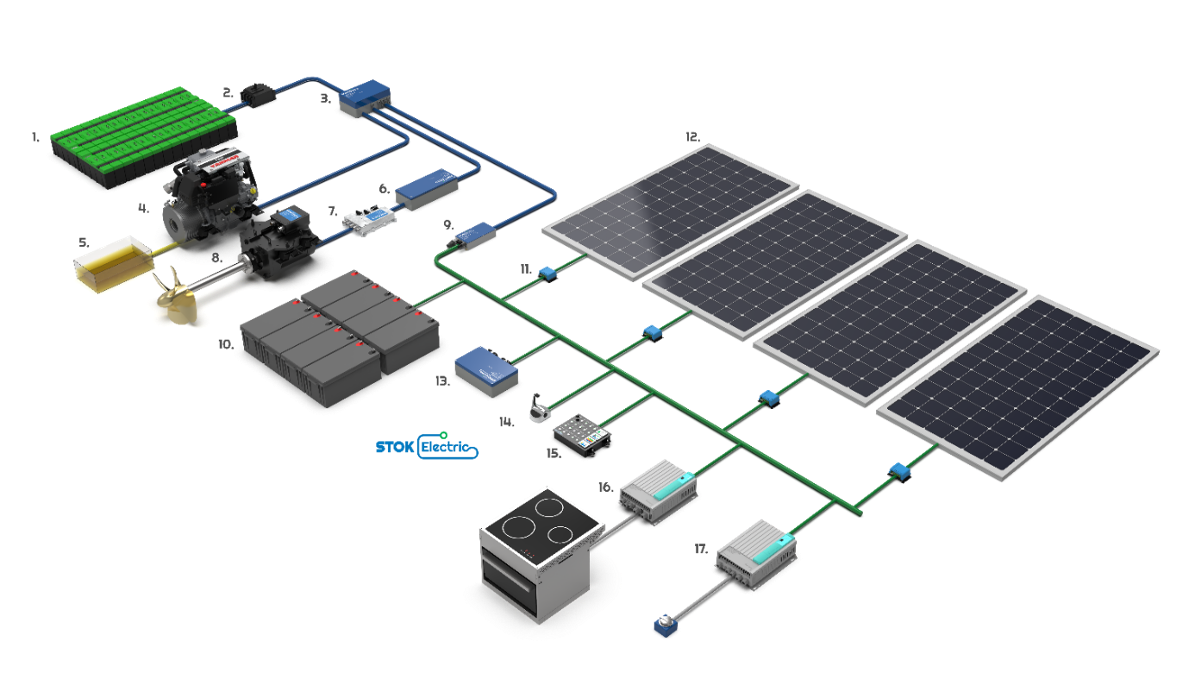
11 Aug How does the energy system of a Hybrid sailing yacht look like?
In this blog you will read how the energy system of the Hybrid sailing yacht: 56 ft Hoek Design ‘Elysium’ looks like. The 56ft Truly Classic Hoek Design ‘Elysium’ will be completely converted into a self-generating, hybrid sailing yacht. This is to make sailing and travel even more environmentally friendly, but also to create more comfort and safety on board.
Hutting Yachts is responsible for the renovations and installation of the energy system, with STOK-Electric taking care of all technology in and around the energy system. In the first blog we paid attention to the advantages and disadvantages of a hybrid sailing yacht; why would you do it? The reasons of the owner of ‘SY Elysium’ and the technical advantages and disadvantages according to STOK-Electric are explained here. In this second blog, the entire energy system is explained. For each part we explain what the part is and how it works.
1. Main Battery Bank
For the main power source of our system, we use a high-quality battery pack. The use of Lithium Iron Phosphate batteries instead of Li-ion batteries is what makes our battery bank stand out from commonly used batteries in electric vehicles. With this battery technique it’s possible to reach almost the same energy density of Li-ion batteries while also increasing safety. LiFePo4 batteries can be extinguished with (sea)water, which is a big plus for ocean-going vessels.
Besides the increased safety, our battery pack is also very customizable depending on the available space and required power of the ship. Because the batteries are built in a brick shape, we can easily spread them on the vessel, improving weight distribution and making optimal use of the available space.
Our battery bank runs at 350V nominal, this can be scaled up and down, depending on the vessel. A higher voltage is necessary for larger vessels to reduce the currents and the risk of fire.
2. Main Switch
Directly after the batteries, we implement the second stage of safety, the first being the BMS (Battery Management System) in the batteries themselves. The second stage is a switch that will trigger automatically if the system draws too much current. This switch also allows for safe maintenance on the system because it can be turned on and off manually.
3. Battery Distribution Box
The battery Distribution Box distributes the connections from the Main Battery Bank to the rest of the systems. The box is placed close to the electric motor and generator to reduce the number of high voltage cables required. Besides this, it also houses several safety features, like fuses.
4. DC Generator
The DC Generator is used as a back-up for the batteries when long-term load is being drawn, for example, when extended motoring is required. We chose a DC-generator because it can be much more compact than AC generators while maintaining the same power output, as well as the ease of implementation in our system. A DC generator is more compact because it can be used at any rpm, instead of the fixed rpm of an AC generator.
5. Fuel tank
The generator is connected to the existing fuel tank, In case of using multiple fuel tanks and because of the low consumption/usage of the generator, it is worth considering using one fuel tank as a water tank instead.
6. Motor Filter Box
The motor filter box is used to cancel out the electrical noise going to the motor drive. This ensures that the motor drive always receives a clean signal and can propel the electric motor smoothly.
7. Motor Drive
The motor drive is used to control the electric motor, the drive is fully integrated in the system and outputs all the necessary data of the motor back to the user.
8. Electric Motor
We offer a large range of reliable electric motors; we can easily vary the speed and power output of the motor, depending on the application. The electric motors come with a flexible coupling adjusted to fit the propeller shaft.

9. Low Voltage Converter
This converter is the only interface between the 350V system and the low voltage 24V side. By separating these systems, we can reduce the size of the 350V system. This converter can work in both directions, which means it can charge the main battery bank from the solar power as well as the shore power; but it can also charge the secondary battery bank from the main battery bank. This way all batteries in the system are connected and share each other’s power.
10. Secondary Battery Bank
The secondary battery bank is used to power the 24V system. If the vessel already has existing batteries for the 24V system, these can either be reused or upgraded to newer or larger batteries.
11. Solar Converters
The solar converters are the interface between the solar panels and the rest of the system. These are also scalable on the available power from the solar panels
12. Solar Panels
The solar panels charge all batteries in the system and ensure that the batteries can also be charged during sailing.
13. Battery Control Box
The Battery Control Box is the brain of the system. It checks if all parts are operating correctly. It has, for example, full control over the main battery bank and checks if they’re all at a good status.
14. Throttle Control
We offer a fully integrated Vetus control system for the vessel. This includes the throttle lever as well as an ignition switch and a system status display.

15. Main Control Panel
The Main Control Panel is a panel which displays all information on the ship and the system. It has physical LED buttons to toggle all systems such as pumps, winches, lights, etc.
16. Hotel Load Inverter
The Hotel Load Inverter is used to deliver power from the 24V system to all 230V applications, like the induction cooker.
17. Shore Power Inverter
The Shore Power Inverter is used to charge the system from the shore, so the batteries are topped up for the next sailing adventure.
Current status project ‘Elysium’
The work on making the sailing yacht hybrid is in full swing. Read and view all updates of the project here. For example, the diesel engine was recently converted into a diesel generator using a dynamo and a controller. The entire 24V system has also been adapted and a distribution and control box is being built. In addition to these technical aspects, the sailing yacht is currently in the painting workshop of Hutting Yachts where the hull is being repainted and all the paintwork is renewed.
Curious about the possibilities that Stok-Electric and Hutting Yachts offer for making your sailing yacht hybrid? Contact us for more information!




